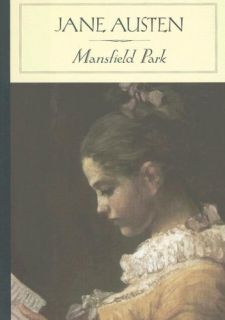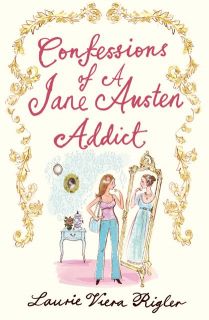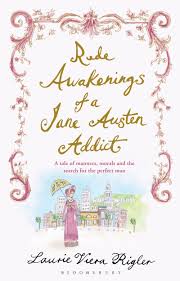|
|
Mansfield Park: First Impressions, Shifting Loyalties
by Laurie Viera Rigler

When I first read what many consider to be Austen’s most controversial novel, I wasn’t thrilled. Although I have developed, over the years, a deep admiration for this work, in some respects my first impressions of Mansfield Park remain intact today. For Mansfield Park differs from Austen’s other major works in a few significant ways.
The most striking, and, to this reader, the most challenging difference, is its heroine, Fanny Price. She, unlike all of the other Austen heroines, is not someone that most readers would like to be. Even those who admire Fanny’s moral fortitude are more likely to imagine themselves as the “light, and bright, and sparkling” Elizabeth Bennet or the quietly steadfast Anne Elliot. Austen may have thought of Emma as “a heroine whom no one but myself will much like,” but at least the self-important, self-appointed queen of Highbury has an enviable degree of autonomy and power that few ladies of her day could boast, while Fanny is, as Mrs. Norris enjoys reminding her, always “the lowest and last.” She is also not remotely what anyone would call the life of the party. In fact, I can think of but one instance in the entire novel where the timid, fearful, and nearly humorless Fanny Price is even tempted to laugh at a joke.
In Fanny’s defense, she didn’t exactly choose the path that formed her personality. Not only was she torn from her childhood home (and her horribly negligent parents) at a young age, she was then systematically suppressed and oppressed by the powers-that-be at Mansfield Park. It’s no wonder that such early and continuing life experiences would produce the antithesis of a lighthearted young woman. Fanny thinks seriously, enjoys seriously, suffers seriously.
Mary Crawford, however, is a different story. Lively and brimming with humor, Mary is Fanny’s polar opposite. Although she is set up as Fanny’s rival in love and the anti-heroine of the piece, Mary has a definite appeal that plays with reader loyalties. She may be the worst sort of material girl, but at least she’s up front about it. And despite her self-confessed selfishness, Mary has a great capacity for affection, especially for her brother and sister. She is also compassionate towards Fanny (though her kindness is often cluelessly misdirected). Most important, at least for this reader, Mary has a sense of humor. And quite a wicked one. Who could forget her infamous pun on “rears and vices” or her “What gentleman among you am I to have the pleasure of making love to?” It is interesting to note that Austen scholar Emily Auerbach, author of Searching for Jane Austen, has compared several lines of Mary’s dialogue with lines from Jane Austen’s own letters and makes a convincing argument that in some respects, Mary’s lively social persona may indeed bear a stronger resemblance to the author than her morally upright heroine.
Mary is, above all, a social firecracker, and lord knows the staid atmosphere of Mansfield Park could do with a bit of shaking up. After all, this is a place where the introduction of home theatricals (Quick, fetch my aromatic vinegar!) not only gets
Fanny’s knickers in a twist, but also those of her like-minded cousin, Edmund Bertram, the elusive object of her affections.
Which brings to mind two more significant differences between this novel and Austen’s other major works.
First and foremost of the two is Edmund, the hero of Mansfield Park. Second is the aforementioned play. Edmund was, and still is, at least for this reader, the most unappealing of Austen’s heroes. Even Sense and Sensibility’s Edward Ferrars, who not only had the poor taste to engage himself to Lucy Steele, but also misled Elinor into believing he was still on the market, doesn’t even come close to Edmund. Yes, Edmund was kind to Fanny when she was a child. But his obliviousness to her romantic feelings for him, his throwing in her face his blind preference for Mary Crawford, and his self-righteous prudishness, outweigh his often powerless attempts to mitigate Fanny’s subservient role at Mansfield Park.
Then there is the play. While one of the delights of reading Austen is the timelessness of its themes, so is the exoticism of its long-ago manners, mores, and window dressing. Guys in tight pants and long-tailed coats? Yes, please. Carriage rides? Count me in. Entailing an estate? Okay, that needed a bit of explaining. But putting on a play at home for one’s family and a couple of neighbors equals highway to hell? That just doesn’t translate to a modern reader. Even the Mansfield Park characters themselves are split as to whether or not they are doing anything objectionable. One needs to do considerable cultural detective work for any of it to make sense to a twenty-first-century reader. It is only then that one has any chance of understanding that putting on this particular play (Lovers’ Vows) with this particular group of people in this particular situation (especially the female players, who are single, one newly engaged, and whose father is far from home) would be the modern equivalent of a group of sheltered teens planning an unauthorized and semi-wild party in their strict parent's home while said parent was out of town.
Not that I understood any of that when I first read Mansfield Park.
Despite my issues with the novel, I was so smitten with Austen’s other five major works that I knew in my heart to stick with Mansfield Park until it began to reveal its treasures. It is, after all, a work by Jane Austen, whose other productions have continued to delight and reveal new layers of storytelling mastery and wisdom with each successive reading. Which is why I faithfully reread Mansfield Park again and again, trusting that Austen’s genius would eventually become clear to me in this work.
After several readings, new vistas began to open up. Slowly I began to see Mansfield Park as uniquely masterful, despite its challenging heroine and hero. Slowly I began to understand that, in fact, the very act of juxtaposing such a pair with their amoral counterparts in the form of Mary Crawford and her brother Henry was a great part of its genius.
Fanny and Edmund may be a pretty unexciting pair on their own, but coupled with Mary and Henry Crawford, who are unendingly fascinating to watch, Fanny and Edmund are rendered interesting. The respective effects that these two paragons of virtue have on the bad boy and bad girl of Mansfield Park give the story its engine, and thus Mansfield Park takes us on a complex and fascinating journey of rivalries, jealousies, and unlikely pairings and unpairings between Fanny, Edmund, and the Crawfords, with a good deal of conflict thrown into the mix in the form of Edmund’s sisters vying for Henry’s affections. There is an incomparable sophistication to the plotting and style of this novel, which is filled with suspense, a suspense that transports this reader no matter how many times it is read. That suspense is such that I have often wondered to what degree the author herself might have been in the dark as to how the book would end, and which characters would end up with one another.
While the other books in the canon could have only ended as they did, Mansfield Park stands alone as the one novel that truly “could have all turned out differently,” as stated in the voice-over of the much-debated film adaptation by Patricia Rozema. Mansfield Park is the only one of the canon where we as readers can spend hours, days, or weeks hotly speculating alternate histories and defending our respective points of view: What if Fanny had said yes to Henry? Would he have reformed? Would he have resisted the impulse to soothe his vanity by flirting with Maria? Or would he have carried on as before once he completed his conquest of Fanny? Can true love reform a rake? Or tame a material girl? If, indeed, what they feel is true love? What if Edmund had married Mary? Would he have loosened up a bit more, and would she have learned to be a bit more comfortable with the idea of being the wife of a clergyman? Or would she be forever nagging Edmund to live a more expensive and worldly life?
These are questions we can debate forever, for Mansfield Park cleverly does not provide us with definitive answers but rather leaves those questions tantalizing open.
Mansfield Park also has some powerful sensory description—only Persuasion comes close to it. This element of style is particularly noteworthy, as Austen has often been admired for her economy of words, and her works are typically spare of physical detail. She did, after all, write for her contemporaries, who could fill in the rest with their experiential knowledge of the period. In Mansfield Park, there is still that controlled economy of words, but the physical descriptions which Austen chose to include are woven so skillfully and organically into the plot that they enhance rather than slow down the action. Take the amber cross and the chains, which serve as metaphors for which of Fanny’s friends is all flash and deception, and which is the perfect fit. Or the locked gate and the oppressive heat of the grounds of Sotherton, which denote Maria’s feelings of being closed in and foreshadow her recklessness in freeing herself. Or the treasures in Fanny’s freezing attic room reminding her of the kindnesses of her family and her feelings of obligation to them, while at the same time underscoring the coldness of her isolation and inferior position in the household.
In the face of all that isolation, I grew to respect and even admire Fanny Price. Here is a woman who has been told since childhood that she is the lowest of the low, and yet she has the backbone to stand up to the biggest and most formidable male authority figure in her life, the person under whose very roof she lives, and say No to what he and everyone around her wants her to do—simply because she follows her inner guide. “We have all a better guide in ourselves, if we would attend to it, than any other person can be.” These are Fanny’s words, and they comprise what is perhaps my favorite Austen quotation of all.
It is not only Fanny’s strength that earned my respect, it is her flawed humanity. The more I thought about this troubled heroine, and the more I understood about The Play in its cultural and social context, the less I was able to dismiss Fanny as nothing more than a buzz-killing Miss Perfect. After all, for much of the story, she is eaten up with jealousy as she watches Edmund fall for Mary, most especially during their interactions regarding said play—and who among us has not struggled with that singularly ugly emotion? Fanny’s jealousy and insecurity make her far from perfect, and all too human.
Fanny may not be the life of the party, but she’s got generosity and compassion, even for her worst oppressors. Most of all, she possesses a strength that few could rival. She even has the courage to risk bringing up the slave trade as a topic of conversation with a family who likely benefits from that trade—and is answered with the resultant “dead silence.” She may not excel in the sort of sparkling social conversation that Mary has mastered, but in the final analysis, Fanny’s qualities count for a great deal more.
All rights reserved by Laurie. V Rigler
About the Author:

Laurie Viera Rigler’s novels Confessions of a Jane Austen Addict and Rude Awakenings of a Jane Austen Addict could have been considered semi-autobiographical had they not involved time travel and body switching. Her short story Intolerable Stupidity, in which Mr. Darcy brings charges against all the writers of Pride and Prejudice sequels, spin-offs and retellings, appears in the anthology Jane Austen Made Me Do It. In addition to having three more novels in the works, including the third in her Austen Addict series, Laurie is the creator of the web series Sex and the Austen Girl, all 23 episodes of which can be found on her online home, janeaustenaddict.com. A longtime resident of the very same Echo Park / Silverlake neighborhood in Los Angeles in which Rude Awakenings of a Jane Austen Addict is set, Laurie now lives in nearby Pasadena, California with her filmmaker husband and their cat.
 
© Jane Austen Society NL. De teksten op deze website mogen niet doorgeplaatst worden zonder toestemming. Citeren mag alleen met bronvermelding. Neem contact op voor meer informatie via info@janeaustensociety.nl© Jane Austen Society NL. It's prohibited to use the content of this website without permission. Quoting only with acknowledgement of source. Please contact info@janeaustensociety.nl for more information.
|